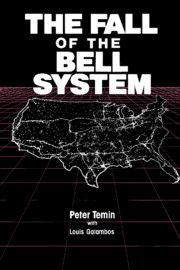Book contents
Introduction
Published online by Cambridge University Press: 06 January 2010
Summary
The forces that would break apart the mighty Bell System within fifteen years were already visible in 1970 to those who cared to look. No one, however, could have known how these forces would interact to produce AT&T's divestiture on January 1, 1984. Action could be seen, reaction only imagined. Two discussions at meetings of the time reveal the knowledge of these forces that existed at the start of the 1970s. One took place in a public professional meeting. The other occupied a regularly scheduled gathering of Bell System executives. The two episodes reveal differing aspects and perceptions of the emerging telecommunications “problem” – and some of the ideas and forces that would interact to determine its resolution.
The first interchange took place at a meeting of antitrust lawyers in the spring of 1970. Howard Trienens, a partner in Sidley and Austin, the giant Chicago law firm that handled much of AT&T's federal regulatory business, moderated a panel of distinguished lawyers that included Commissioner Kenneth Cox from the Federal Communications Commission (FCC) and Professor William Baxter from the Stanford Law School. Trienens opened a brief discussion of competition in telecommunications by responding to Cox's description of the FCC's recent decision to allow Microwave Communications, Inc. (MCI), then a tiny new company, to sell private line services (i.e., telecommunication services that did not go through Bell's national switched network) between Chicago and St. Louis. Trienens asserted that the MCI decision did not involve the issue of competition squarely because the new firm had applied to the FCC for permission to offer a new, low-quality service unobtainable from the Bell System.
- Type
- Chapter
- Information
- The Fall of the Bell SystemA Study in Prices and Politics, pp. 1 - 8Publisher: Cambridge University PressPrint publication year: 1987



